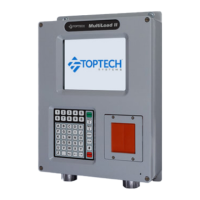CHAPTER 9 DATA COMMUNICATION NOTES AND RECOMMENDATIONS
This topic provides some basic communications concepts, as well as Toptech's recommendations for achieving
optimum performance.
9.1 PROTOCOL SELECTION: RS-232 VS. RS-485
9.1.1 RS-232
RS-232 communications protocol was designed for point-to-point (i.e., computer to a single device)
communications for short distances. The actual specification for RS-232 distance is limited to 50 feet. In
practice, however, RS-232 communications can be successful at distances over 1000 feet. We generally try to
limit distances to 500-600 feet. RS-232 requires a minimum of 3 wires: Transmit, Receive and Signal ground
wires. More wires are required for hardware handshaking. RS-232 can work on straight, non-twisted-pair wiring.
If existing wiring that is not twisted-pair must be used, then RS-232 protocol should be used.
9.1.2 RS-485
RS-485 communications protocol was designed for multi-point (i.e., computer to multiple devices, also called
multi-dropped) communications and can support distances over 5,000 feet. RS-485 requires 4 wires (2 twisted-
pair) for normal full-duplex communications. With special hardware, 2-wire half-duplex RS-485 can be
accomplished. RS-485 utilizes a transmit pair of wires (TDA and TDB) and a receive pair of wires (RDA and
RDB). A ground wire is not recommended normally, although some devices may have a terminal block for an
RS-485 ground. Most multi-dropped devices require RS-485 communications. When installing new wiring, RS-
485 twisted-pair wiring is preferred.
9.2 CABLE SELECTION
The speed and distance of communications is mostly affected by the capacitance and resistance of the wiring.
Copper wiring is generally low resistance, so this is not normally the limiting factor. Capacitance, however, can
vary greatly from one type of wire to another. In general, the larger the wire, the higher the capacitance. Wiring
size of 20 to 24 gauge is typically best for data communications. Capacitance of 16pf or less is preferred. With
16pf cable, 9600 baud communications can operate over 1000 feet for RS-232, and over 5000 feet for RS-485.
Doubling the capacitance will generally halve the baud rate or the distance.
Data communications cable should always be shielded. Individual wires or pairs do not need shielding, but an
overall shield should always be used. Whenever possible, always run data communications cable in conduit
and protected from moisture. Moisture can invade most cable coatings and disrupt data communications
integrity. For exposed routing or direct burial, Teflon coatings are recommended. Armored cable is also
available for running over-head without conduit.
RS-232 communications will work over almost any type of wiring, although speed and distance may be limited
by some wiring. Straight (individual) wires or twisted-pair wiring can be used. RS-485 communications requires
twisted-pair wiring with an impedance of 100 ohms.
For new installations, if you select wiring suitable for RS-485 wiring, it will always work for RS-232. This will
provide the ability to change from one communications protocol to another without replacing the wiring.
9.3 LINE TERMINATION IN MULTI-DROPPED COMMUNICATIONS
Toptech Systems has specialized hardware that will support multi-dropping of devices on a single RS-232
communication line. This is accomplished by tri-stating or disconnecting the transmitter of a device when it is
not transmitting on the communications line. This is similar to the RS-485 multi-dropping method. Due to the
tri-stating of the transmitters, the transmit circuit is 'floating' when no device is transmitting. This can sometimes
cause problems for the computer's receiver circuit, usually framing errors or break conditions.

